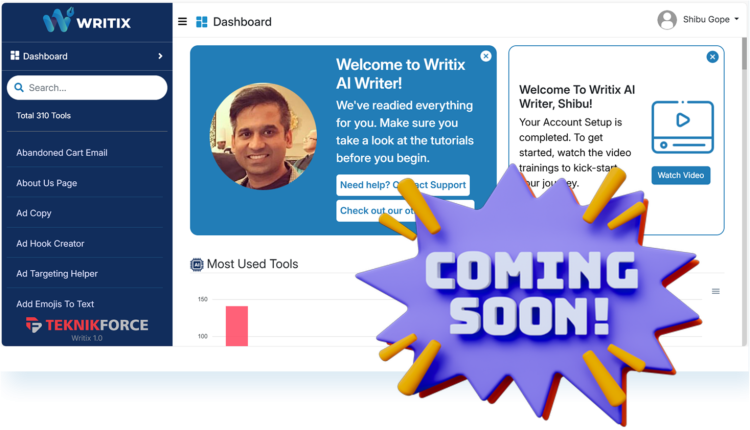Prompt Fatigue Cure: This AI Workflow Software Is Automating Prompt Engineering
Key Takeaways:
- Prompt fatigue is causing widespread burnout, with active AI users experiencing 45% higher burnout rates than non-users.
- Half of business leaders report declining employee enthusiasm for AI adoption despite its potential benefits.
- Writix offers automated AI workflows that eliminate the need for manual prompt engineering, potentially solving prompt fatigue issues.
- Traditional prompt engineering creates a significant cognitive burden that represents a hidden productivity cost for businesses.
- Workflow automation software is the most practical solution to combat prompt fatigue while maintaining AI benefits.
AI tools are transforming businesses across industries, but there’s a hidden cost many aren’t addressing. As employees struggle to keep up with constantly evolving AI systems, prompt fatigue is becoming an increasingly serious problem that undermines productivity and mental wellbeing. This growing issue requires practical solutions that can help businesses maintain AI adoption without burning out their workforce.
Prompt Fatigue: The Hidden Cost of AI Adoption
Organizations everywhere are racing to implement AI solutions, but in their rush, many overlook the toll it’s taking on employees. According to recent studies, 50% of business leaders report declining enthusiasm for AI adoption among their workforce, while 65% struggle to keep employees motivated to use new technology. Behind these statistics lies a growing phenomenon called prompt fatigue.
The constant pressure to craft perfect AI prompts, stay updated with evolving AI capabilities, and integrate these tools into daily workflows is creating a significant mental burden. This challenge is particularly acute in marketing, content creation, and other departments where AI tools are being heavily deployed. Writix, an innovative AI workflow software, offers a solution to these challenges by automating the prompt engineering process. that contributes to mental exhaustion.
What Exactly Is Prompt Fatigue?
Prompt fatigue describes the mental exhaustion that comes from continuously crafting, refining, and optimizing prompts for AI systems. This specialized form of AI fatigue occurs when users must repeatedly invest mental energy into formulating the perfect instructions for AI tools to deliver useful outputs. The more dependent users become on AI for daily tasks, the more this fatigue accumulates.
1. Signs of AI and Prompt Burnout
Prompt fatigue manifests in several recognizable ways across organizations:
- Decreased productivity despite AI implementation
- Rising frustration when working with AI tools
- Avoidance of AI systems despite their potential benefits
- Inconsistent results from AI tools across teams
- Increased stress when approaching AI-assisted tasks
Studies show that active AI users experience burnout rates 45% higher than non-users, according to research from Quantum Workplace. This statistic reveals the counterintuitive reality that tools designed to increase productivity may actually be contributing to workforce exhaustion.
2. Why Traditional Prompt Engineering Falls Short
The traditional approach to prompt engineering places enormous cognitive burden on employees, who must:
- Continuously learn new prompt techniques and best practices
- Anticipate how AI will interpret different phrasings
- Maintain context across multiple interactions
- Track changes in AI capabilities with each update
- Document successful prompts for future reuse
This constant mental effort represents a hidden tax on productivity that many organizations fail to account for when calculating the ROI of their AI investments.
3. The Business Impact of Employee AI Fatigue
The consequences of prompt fatigue extend beyond individual frustration. Organizations experience tangible negative outcomes including:
- Inconsistent quality in AI-generated outputs
- Lower adoption rates of expensive AI tools
- Increased time spent troubleshooting rather than working
- Rising anxiety about job security (32% of workers aged 18-24 worry AI will make their jobs redundant)
- Higher turnover among technically skilled employees
The Writix Solution: AI Workflow Automation
As businesses search for answers to the growing challenge of prompt fatigue, workflow automation tools like Writix are becoming a practical solution. Unlike standard AI tools that require constant prompt crafting, Writix takes a fundamentally different approach by automating the entire prompt engineering process.
This workflow automation tool delivers pre-built prompting sequences that handle all the complex interactions with AI models. The result is a significant reduction in cognitive load for employees who no longer need to become prompt engineering experts to effectively use AI in their daily work.
1. How Ready-Made Workflows Replace Manual Prompting
Traditional prompt engineering follows a laborious cycle:
- Craft an initial prompt
- Analyze the AI’s response
- Refine the prompt based on results
- Repeat steps 1-3 multiple times
- Document successful prompts for future use
This process consumes significant time depending on the complexity of the task. Writix aims to eliminate this cycle by providing purpose-built workflows that encapsulate prompt sequences developed specifically for business and marketing tasks.
With these ready-made workflows, users select their desired outcome, provide basic inputs, and the system handles the prompt engineering behind the scenes. This approach is designed to reduce the time needed to generate content to under a minute in many cases.
2. Integration with Multiple AI Models
Another advantage of workflow automation software like Writix is the ability to use multiple AI models within a single interface. Rather than requiring users to understand the strengths and weaknesses of different AI platforms, the system routes tasks to appropriate models for specific needs.
This multi-model approach offers several potential benefits:
- Outputs tailored to specialized AI models’ capabilities
- Reduced need for employees to learn multiple AI platforms
- Access to various AI capabilities through a consistent interface
- Simplified workflow regardless of the underlying complexity
By handling the technical details of which AI model to use when, Writix allows employees to focus on their core responsibilities rather than becoming AI specialists.
3. No Technical Skills Required
Perhaps the most significant benefit of workflow automation is making AI accessible to more users. Traditional prompt engineering requires specialized knowledge that creates a barrier to AI adoption, particularly among non-technical team members who may have the most to gain from AI assistance.
Writix’s approach aims to remove this barrier by providing:
- Interfaces focused on outcomes rather than techniques
- Input fields that collect only necessary information
- Plain-language options that avoid technical jargon
- One-click generation that simplifies multi-step processes
This accessibility ensures that team members across various departments can potentially use AI capabilities without specialized prompt engineering expertise.
Real Business Benefits of Automated Prompt Engineering
Beyond addressing the immediate problem of prompt fatigue, workflow automation delivers tangible business benefits that impact the bottom line. These advantages help explain why many organizations are shifting toward automation for their AI strategy.
1. Time Savings: Content in Under a Minute
A measurable benefit of automated prompt engineering is time savings. Tasks that previously required multiple rounds of prompt refinement can potentially be completed with fewer steps. For many common business and marketing tasks, Writix aims to reduce completion time to under a minute.
These time savings can compound across the organization:
- Marketing teams can produce campaign assets more efficiently
- Customer service can generate responses faster
- Sales teams can customize outreach more effectively
- Product teams can quickly generate support materials
When implemented across multiple employees, these efficiency gains can represent productivity improvements for businesses adopting AI workflow automation.
2. Reduced Employee Burnout and Higher Productivity
The high burnout rates among active AI users (45% higher than non-users) represent a significant hidden cost for organizations. By reducing the cognitive load associated with prompt engineering, workflow automation tools address this growing problem.
The potential benefits include:
- Reduced technical anxiety when working with AI tools
- Increased willingness to adopt AI when the learning curve is less steep
- Less frustration leading to potentially higher job satisfaction
- Energy previously spent on prompt crafting redirected to creative and strategic thinking
This reduction in technical cognitive load is particularly valuable for creative professionals and subject matter experts who can focus more on their core expertise rather than being distracted by the mechanics of AI interaction.
3. Consistent Quality Across Teams
One of the challenging aspects of traditional prompt engineering is the potential inconsistency of results. Two employees with different prompting skills can get varying outputs from the same AI tool, leading to quality differences across the organization.
Workflow automation aims to address this challenge by standardizing the prompting process. Potential benefits include:
- More consistent brand voice across AI-generated content
- More reliable quality regardless of which team member initiates the request
- Standardized outputs that better meet quality requirements
- Reduction of variance where outputs differ based on prompt phrasing
This consistency is particularly valuable for larger organizations where maintaining brand standards and quality control across distributed teams has traditionally been challenging.
The Future of AI Work is Automated Prompting
As AI continues to evolve and integrate more deeply into business processes, the trend toward automated prompting is likely to grow. We are witnessing an important shift in how organizations approach AI implementation.
The first wave of AI adoption focused on capabilities by discovering what these new tools could do. The current wave centers on integration by fitting these tools into existing workflows. The emerging wave appears to be moving toward automation, removing friction points in AI interaction.
This progression follows a pattern seen with previous technological innovations. Early adopters focus on capabilities, mainstream adoption requires integration, and maturity brings automation that makes the technology more accessible.
For organizations looking to address prompt fatigue, implementing workflow automation solutions represents a practical approach. By addressing this challenge now, these organizations can potentially:
- Scale their AI implementation more effectively
- Support better employee satisfaction with AI tools
- Achieve greater consistency in AI outputs
- Better position themselves to adopt new AI capabilities as they emerge
The businesses that recognize and address prompt fatigue today may be better positioned to use AI’s potential without the hidden costs of employee burnout and decreased productivity.
As prompt engineering becomes increasingly automated, the focus can shift from technical AI skills to strategic application. The question will no longer be just how to use the tools but what to use them for. This shift allows organizations to concentrate more on the human aspects of work—creativity, strategy, empathy, and judgment—while automating complex technical interactions with AI systems.
For teams struggling with prompt fatigue, workflow automation tools like Writix offer a potential solution. Rather than continuing to invest time and energy into mastering the evolving art of prompt engineering, these automated solutions allow teams to focus more on creating value for their organization and customers.
Visit MunchEye to learn about Writix’s AI workflow solutions that help businesses create better content faster while reducing prompt fatigue.
{video_pr:link}


Comments are closed.